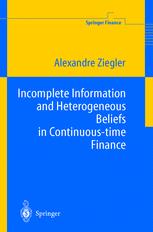

Most ebook files are in PDF format, so you can easily read them using various software such as Foxit Reader or directly on the Google Chrome browser.
Some ebook files are released by publishers in other formats such as .awz, .mobi, .epub, .fb2, etc. You may need to install specific software to read these formats on mobile/PC, such as Calibre.
Please read the tutorial at this link: https://ebookbell.com/faq
We offer FREE conversion to the popular formats you request; however, this may take some time. Therefore, right after payment, please email us, and we will try to provide the service as quickly as possible.
For some exceptional file formats or broken links (if any), please refrain from opening any disputes. Instead, email us first, and we will try to assist within a maximum of 6 hours.
EbookBell Team

0.0
0 reviewsContinuous-time finance was developed in the late sixties and early seventies by R. C. Merton. Over the years, due to its elegance and analytical conve nience, the continuous-time paradigm has become the standard tool of anal ysis in portfolio theory and asset pricing. However, and probably because it was developed hand in hand with option pricing, in which investors' expecta tions were thought not to matter, continuous-time finance has for a long time almost entirely neglected investors' beliefs. More recently, the development of martingale pricing techniques, in which expectations playa dominant role, and the blurring boundary between those methods and the original methods of continuous-time finance based on the Ito calculus, have allowed expecta tions to regain their central role in finance. The habilitation thesis of Professor Alexandre Ziegler is entirely devoted to the role of expectations in continuous-time finance. After a brief review of the literature, the author analyzes the consequences of incomplete informa tion and heterogeneous beliefs for optimal portfolio and consumption choice and equilibrium asset pricing. Relaxing the assumption that investors can ob serve expected dividend growth perfectly, the author shows that incomplete information affects stock prices and their dynamics, thus providing a potential explanation for the asset price bubble of the late 1990s. He also demonstrates how the presence of heterogeneous beliefs among investors affects their opti mal portfolios and their optimal consumption patterns.